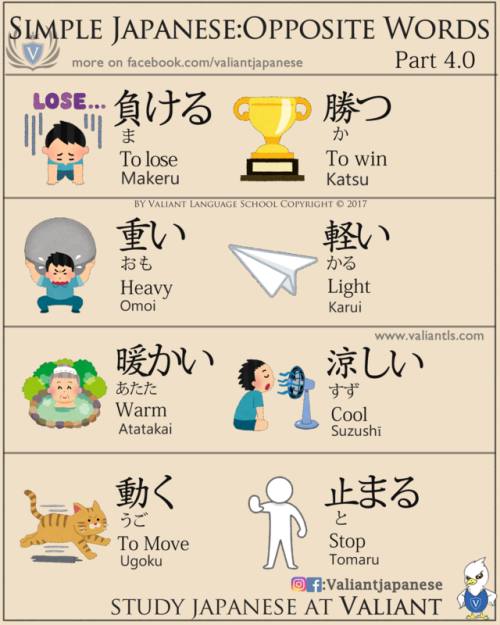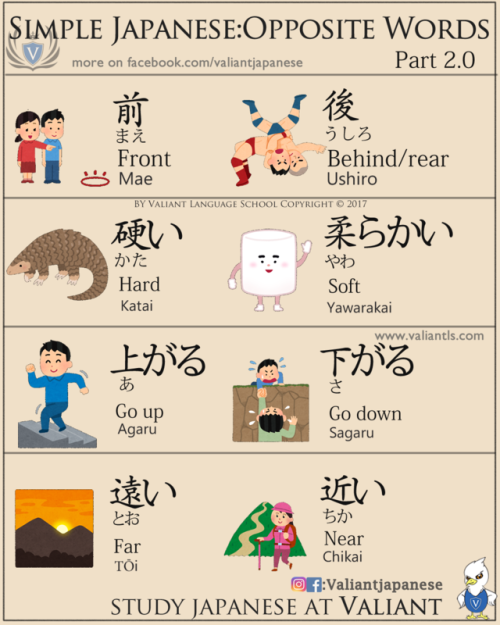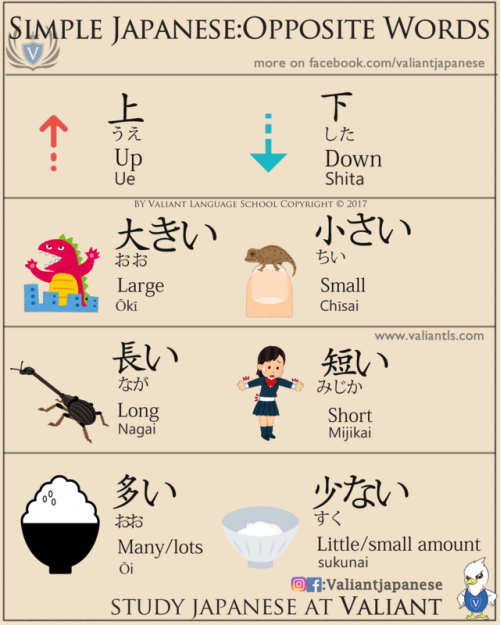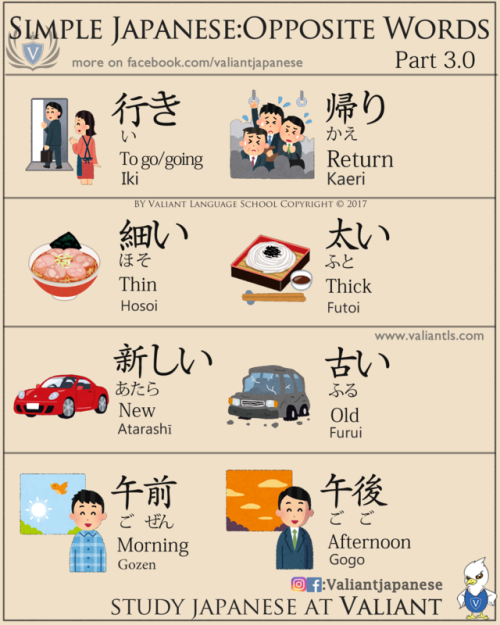The Opposite Words In Japanese




The Opposite Words in Japanese
Follow us on www.instagram.com/valiantjapanese
More Posts from Earthquakedeer and Others
伊達メガネ
伊達メガネ (だてめがね) - glasses that are just a fashion accessory, not something one needs because of bad eyesight
The first word, 伊達, means “elegance, having style, doing something just for show” and メガネ is, of course, “glasses”.

Sometimes, when we are presenting, our bodies act completely irrationally. Sweating, stuttering, or just shutting down completely are all things I have encountered during public speaking; behaviour that is usually connected to extreme danger and fleeing behaviour. Completely unnecessary, as your teacher won’t kill you (hopefully), but trying to convince your body to be just as rational is a tough task. Turns out that this is exactly what we’re going to do.
The basis for this (personal) advice all lies in my musical training, where posture is extremely important. Performance practice lessons have taught me one important thing: you can trick your body into thinking it’s okay, and with that, your audience. disclaimer: I have posted this information before in a slightly different way. Regard this as an updated version. Hopefully one with better spelling.
hoooooow???
Stand up and try to follow these instructions. I’m your only audience right now, so mistakes aren’t a problem.
Start by relaxing your shoulders. Many people tense their shoulders when they’re anxious, which is a very natural reaction. However, tension in your shoulder automatically reaches through to your back and arms, and even your neck, tensing up your entire upper body. It’s confirming to your brain that yes! this is scary! Well, brain is wrong and we’re going to prove it wrong by relaxing our shoulders. Just let them hang down (make sure you don’t start leaning forward though, it should be just your shoulders). Doesn’t that immediately feel more relaxed?
Keep your feet a little bit apart, firm on the ground. This sends the message to your brain and audience that a single push will not have you fall over. Standing with your legs closely together simply isn’t as stable, and you want to radiate stability and confidence. Even if you’re feeling dizzy, this simple way of pretending will keep your feet on the ground. Literally.
Chin up, back straight, eyes at the audience. I used to tend to look at the ground, or to lean forward. No, no no! You want to maintain an open posture, and to address the entire audience. When you do this, you’ll look more secure, and maybe you’ll even notice people will listen to you more closely. Make sure you address the entire room, and not just one spot. if you’re scared to look at faces, look at the back wall. But not just one spot, find some nice different wall spots to look at.
What to do with your hands? I know I used to put my hands in my pocket, or fidget with something. Instead, try to talk with your hands more. When you’re using gestures, people will usually pay more attention to what you’re saying, and they’ll sometimes understand more easily (if you’re interested as to why, message me).
Do not hide. This is special advice to musicians, too. I used to hide behind my music stand because it was nice and safe. During public speaking it’s easy to hide behind some notes or to stand behind other people of your group, maybe. Don’t. Remember, fake the confident posture till you make it.
When you’re finished, don’t stop pretending just yet. When people ask how it went, always say it went okay. This is so so so important! Because if you’d say “ugh it was awful!! So many things went wrong, I suck at presenting!” they’ll start thinking hmm, yeah, there were indeed some mistakes… Could have been better. Whereas if you just say it was okay or good, or even decent, they’ll hardly even question it and will most likely remember the positive aspects, as humans tend to do.
I promise this works, at least to some extent. It may not help you get rid of anxiety right away, especially in really severe cases, but it can help you feel more at ease in front of a group. After that, you can start working on other things, such as volume, intonation, powerpoint use etc.
Just take a few seconds before you start talking to breathe, focus on those muscles, and to follow this with an amazing presentation (and a good grade).
You can always send me an ask for advice on public speaking! Even though I’m not a professional coach or whatever, I have overcome my speaking anxiety and maybe I can be of any help at all <3
Japanese Counters
Counting in Japanese may seem difficult when you first try to tackle it. That’s because of all of the different counters used. Instead of thinking of them as a new speaking rule, try to think of them in the same way as they are used in English. For example; 12 PIECES of paper 6 SLICES of pizza 4 BOWLS of soup and so on Here are the counters you’ll need to know
人(にん/ nin) > People
一人 (ほとり/ hitori) > one person
二人 (ふたり/ futari) > two people
三人 (さんにん/ sannin) > three people
四人 (よんにん/ yonnin) > four people
五人 (ごにん/ gonin) > five people
冊 (さつ/ satsu) > Bound Objects
一冊 (いっさつ/ issatsu) > one bound object
二冊(にさつ/ nisatsu) > two bound objects
三冊(さんさつ/ sansatsu) > three bound obj.
四冊(よんさつ/ yonsatsu) > four bound obj.
五冊(ごさつ/gosatsu) > five bound obj.
台 (だい/ dai) > Mechanical Items
一台(いちだい/ ichidai) >one mechanical obj.
二台(にだい/nidai)> two mechanical obj.
三台(さんだい/sandai)> three mechanical obj
四台(よんだい/yondai)> four mechanical obj.
五台(ごだい/godai)> five mechanical obj.
杯 (はい/ hai) > Liquid in glasses, cups, or bowls
一杯(いっぱい/ippai)> one cup/glass/bowl of
二杯(にはい/nihai) > two cups/glasses/bowls
三杯(さんはい/sanhai)> 3 cups/glasses/bowls
枚 (まい/ mai) > Thin Flat Objects -
一枚(いちまい/ichimai)> one piece of paper
二枚(にまい/nimai)> two pieces paper
三枚(さんまい/sanmai)>three pieces of paper
四枚(よんまい/yonmai)>four pieces of paper
五枚(ごまい/gomai)>five pieces of paper
本 (ほん/ hon) > Long Cylindrical Items
一本(いっぽん/ippon)> one pencil**
二本(にっぽん/nippon)>two pencils
三本(さんぼん/sanbon)>three pencils
四本(よんほん/yonhon)>four pencils
五本(ごほん/gohon)> five pencils
匹 (ひき/ hiki) > Animals
一匹 (いっぴき/ippiki) >one animal
二匹 (にひき/nihiki) > two animals
三匹 (さんびき/sanbiki) > three animals
四匹 (よんひき/yonhiki) > four animals
五匹 (ごひき/gohiki) > five animals
**pencil was used here just as an example of a long cylindrical object.
~In most situations the Chinese origin numbers are used for the counters listed above, but note the words for 1 person and 2 people employ the native Japanese numbers.
Here are the native Japanese Numbers:
一つ > ひとつ > hitotsu > one
二つ > ふたつ > futastu > two
三つ > みっつ > mittsu > three
四つ > よっつ > yottsu > four
五つ > いつつ > itsutsu > five
六つ > むっつ > muttsu > six
七つ > ななつ > nanatsu > seven
八つ > やっつ > yattsu > eight
九つ > ここのつ > kokonotsu > nine
十 > とお > too > ten
**Native numbers are used for things like round objects, furniture, mountains, starts, and other very abstract ideas I also made a song for memorizing the native numbers a while ago, if you’re interested : http://youtu.be/MOupUC5WGVI For example:
1.) 問題が二つあります。>mondai ga futatsu arimasu> there are two problems.
2.) ソファーを一つ買います。>Sofaa wo hitotsu kaimasu > I will buy one sofa 3.) 紙が二十三枚あります。>kami ga nijuusan-mai arimasu > There are 23 pieces of paper
4.)犬が一匹います。> inu ga ippiki imasu > There is one dog.

There’s this theory that in any given language, there are 600 basic words that are really, really good to know, because, you guessed it, they are the most common. Up next: a long list of determiners, including numbers (below the cut because wow, long).
this - これ
that - それ・あれ
my - 私の(わたし)
your - あなたの
his - 彼の(かれ)
her - 彼女の(かのじょ)
It’s a bit rude to use ‘his’ and ‘her’ like this (and 彼女 by itself often means ‘girlfriend’, too), so often you’d use [name]の instead for the same result.
its - Nounの
our - 私達の(わたしたち)
all - 全部(ぜんぶ)・全て(すべて)
some - 何らか(なん)
no - ありません・ない・なし
any - 何でも(なん)
many - たくさん
much - 多い(おお)
more - もっと
a few - 少ない(すく)
several - 複数(ふくすう)
whole - 全体(ぜんたい)
a little - 少し(すこ)
a lot of - 大いに(おお)
both - 両方(りょうほう)・とも
neither - も (In a negative sentence!)
each - それぞれ
every - 毎〇〇
Ex. 毎年(まいとし)=every year
other - 他の(ほか)
another - もう
same - 同じ(おなじ)
different - 違う(ちがう)
such - そういう
Keep reading

There are two forms of sentence structure you can use with prepositions.
topic は something の position(preposition) に あります・います
something の position に subject が あります・います

Boston Post, Massachusetts, April 3, 1921

03.10.17 // 23/100 days of productivity // handwritten
i’ve decided that alongside my general duolingo/lingodeer/etc app time, i’m going to devote my handwritten studies to the stuff I’d need to pass the JLPT N5. I’ve missed the cutoff for this year, but I figure that gives me ample time to make sure i’m fully prepared for next year! Also, I’ve been woeful in my kanji study, so it’s probably a good idea to start taking it seriously.
it’s also day 3 of @athenastudying ‘s October Study Challenge! I keep forgetting about the time difference and getting confused as to why i’m a day ahead (o>艸<)
ig: @hinodestudies

A small list of verbs! Tomorrow I will post a note sheet for conjugating verbs. For now, just remember that ます is present tense when dealing with verbs.
指切り
ゆびきり- “finger cut-off”- pinky promise
In Japan, they say a song when pinky promising.
指切
ゆびきり
Finger cut-off
拳万、
げんまん
ten thousand fist-punchings
(拳万 means if you break your promise you get punched 10,000 times. 拳万 can also be told as “linking little fingers to confirm a promise”.)
嘘ついたら
うそついたら
whoever lies
針千本呑ます
はり せんぼん の〜ます
has to swallow a thousand needles.
指切った。
and cut my finger.
-
 pyorin reblogged this · 4 weeks ago
pyorin reblogged this · 4 weeks ago -
 nissigr liked this · 4 years ago
nissigr liked this · 4 years ago -
 mesyeux liked this · 4 years ago
mesyeux liked this · 4 years ago -
 darekaposts liked this · 4 years ago
darekaposts liked this · 4 years ago -
 pqpqoqo-blog liked this · 4 years ago
pqpqoqo-blog liked this · 4 years ago -
 hisokaschwing liked this · 5 years ago
hisokaschwing liked this · 5 years ago -
 mariosaurio liked this · 5 years ago
mariosaurio liked this · 5 years ago -
 paperwindfeelings liked this · 5 years ago
paperwindfeelings liked this · 5 years ago -
 uchouten-tanuki reblogged this · 5 years ago
uchouten-tanuki reblogged this · 5 years ago -
 massivecollectionpersonsstuff liked this · 5 years ago
massivecollectionpersonsstuff liked this · 5 years ago -
 smilemooore liked this · 6 years ago
smilemooore liked this · 6 years ago -
 tt1781781781 liked this · 6 years ago
tt1781781781 liked this · 6 years ago -
 tt1781781781 reblogged this · 6 years ago
tt1781781781 reblogged this · 6 years ago -
 sickandtiredofyoushithead liked this · 6 years ago
sickandtiredofyoushithead liked this · 6 years ago -
 cassieshawol reblogged this · 6 years ago
cassieshawol reblogged this · 6 years ago -
 katsukiizumi73 liked this · 6 years ago
katsukiizumi73 liked this · 6 years ago -
 spaceinabjodel liked this · 6 years ago
spaceinabjodel liked this · 6 years ago -
 tinm4n reblogged this · 6 years ago
tinm4n reblogged this · 6 years ago -
 tinm4n liked this · 6 years ago
tinm4n liked this · 6 years ago -
 d-velbomm liked this · 6 years ago
d-velbomm liked this · 6 years ago -
 doctorbsmith liked this · 6 years ago
doctorbsmith liked this · 6 years ago -
 comeseekmewherethewildthingsare reblogged this · 6 years ago
comeseekmewherethewildthingsare reblogged this · 6 years ago -
 arachuuu reblogged this · 6 years ago
arachuuu reblogged this · 6 years ago -
 onesanyooooo reblogged this · 6 years ago
onesanyooooo reblogged this · 6 years ago -
 onesanyooooo liked this · 6 years ago
onesanyooooo liked this · 6 years ago -
 half-lights liked this · 6 years ago
half-lights liked this · 6 years ago -
 lysergdiethelphantomive liked this · 6 years ago
lysergdiethelphantomive liked this · 6 years ago -
 alicelance reblogged this · 6 years ago
alicelance reblogged this · 6 years ago -
 ace-off-hearts liked this · 6 years ago
ace-off-hearts liked this · 6 years ago -
 tokyoflavor liked this · 6 years ago
tokyoflavor liked this · 6 years ago -
 eroticcannibal liked this · 6 years ago
eroticcannibal liked this · 6 years ago -
 akire-artist-blog liked this · 6 years ago
akire-artist-blog liked this · 6 years ago -
 indiferens reblogged this · 6 years ago
indiferens reblogged this · 6 years ago -
 indiferens liked this · 6 years ago
indiferens liked this · 6 years ago -
 thekisetsumanagers liked this · 6 years ago
thekisetsumanagers liked this · 6 years ago -
 amritfox liked this · 6 years ago
amritfox liked this · 6 years ago -
 im-afraid-of-dogs liked this · 6 years ago
im-afraid-of-dogs liked this · 6 years ago -
 3m5klan liked this · 6 years ago
3m5klan liked this · 6 years ago -
 ptwrng liked this · 6 years ago
ptwrng liked this · 6 years ago -
 ariettie07 liked this · 6 years ago
ariettie07 liked this · 6 years ago
Just a person learning Japanese. Self-learner. If you're also studying Japanese and want to practice with someone (and you're also very much a beginner) then message me! はじめまして! さびーなです。よとしく!
196 posts

